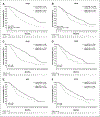Plasma biomarkers as predictors of outcome in patients with advanced hepatocellular carcinoma
- PMID: 22374331
- PMCID: PMC12268944
- DOI: 10.1158/1078-0432.CCR-11-2175
Plasma biomarkers as predictors of outcome in patients with advanced hepatocellular carcinoma
Abstract
Purpose: Validated biomarkers of prognosis and response to drug have not been identified for patients with hepatocellular carcinoma (HCC). One of the objectives of the phase III, randomized, controlled Sorafenib HCC Assessment Randomized Protocol (SHARP) trial was to explore the ability of plasma biomarkers to predict prognosis and therapeutic efficacy.
Experimental design: In SHARP, 602 patients with advanced HCC were randomized to receive either oral sorafenib 400 mg twice a day per os or matching placebo daily on a continuous basis. Ten plasma biomarkers implicated in the pathogenesis of HCC were measured in 491 patients at baseline and in 305 after 12 weeks of treatment. The candidate biomarkers were analyzed to identify correlates of prognosis or predictors of response to sorafenib.
Results: In both the entire patient population and the placebo cohort, baseline angiopoietin 2 (Ang2) and VEGF concentrations independently predicted survival. Clinical variables such as macroscopic vascular invasion, Eastern Cooperative Oncology Group (ECOG) performance status, and baseline α-fetoprotein and alkaline phosphatase concentrations also independently predicted survival in these groups. In the sorafenib cohort, trends toward enhanced survival benefit from sorafenib were observed in patients with high s-c-KIT or low hepatocyte growth factor concentration at baseline (P of interaction = 0.081 and 0.073, respectively).
Conclusions: The angiogenesis biomarkers Ang2 and VEGF were independent predictors of survival in patients with advanced HCC. In contrast, none of the biomarkers tested significantly predicted response to sorafenib.
©2012 AACR.
Conflict of interest statement
Disclosure of Potential Conflicts of Interest
J.M. Llovet and J. Bruix have participated in advisory activities for Bayer HealthCare Pharmaceuticals and Onyx Pharmaceuticals. No potential conflicts of interest were disclosed by the other authors.
Figures




Comment in
-
Biomarkers in hepatocellular carcinoma--letter.Clin Cancer Res. 2012 Sep 1;18(17):4861. doi: 10.1158/1078-0432.CCR-12-1659. Epub 2012 Aug 2. Clin Cancer Res. 2012. PMID: 22859718 No abstract available.
References
-
- Jemal A, Siegel R, Xu J, Ward E. Cancer statistics, 2010. CA Cancer J Clin 2010;60:277–300. - PubMed
-
- Llovet JM, Ricci S, Mazzaferro V, Hilgard P, Gane E, Blanc JF, et al. ; SHARP Investigators Study Group. Sorafenib in advanced hepatocellular carcinoma. N Engl J Med 2008;359:378–90. - PubMed
-
- Cheng AL, Kang YK, Chen Z, Tsao CJ, Qin S, Kim JS, et al. Efficacy and safety of sorafenib in patients in the Asia-Pacific region with advanced hepatocellular carcinoma: a phase III randomised, double-blind, placebo-controlled trial. Lancet Oncol 2009;10:25–34. - PubMed
-
- Llovet JM, Di Bisceglie AM, Bruix J, Kramer BS, Lencioni R, Zhu AX, et al. ; Panel of Experts in HCC-Design Clinical Trials. Design and endpoints of clinical trials in hepatocellular carcinoma. J Natl Cancer Inst 2008;100:698–711. - PubMed
Publication types
MeSH terms
Substances
Grants and funding
LinkOut - more resources
Full Text Sources
Other Literature Sources
Medical
Miscellaneous

